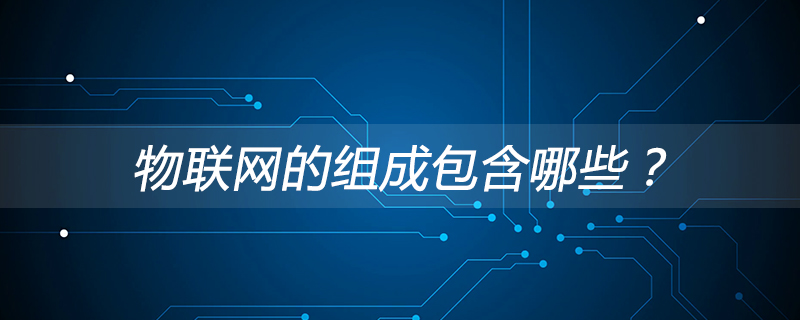Home >Common Problem >What does the Internet of Things consist of?
What does the Internet of Things consist of?
- GuanhuiOriginal
- 2020-05-29 14:11:0914073browse

What are the components of the Internet of Things?
The Internet of Things can be roughly divided into the following four levels, namely: perception layer, network layer, and platform layer and application layer. The details are as follows:
1. Perception and identification layer
The perception layer is the foundation of the overall architecture of the Internet of Things and an important part of the integration of the physical world and the information world. At the perception layer, we can sense the object itself and the surrounding information through sensors, so that the object also has the ability to "speak and release information", such as sound sensors, pressure sensors, light intensity sensors, etc. The perception layer is responsible for collecting and obtaining information for the Internet of Things.
2. Network construction layer
The network layer plays a connecting role in the entire IoT architecture. It is responsible for transmitting sensing information to the upper layer and transmitting commands to the lower layer. The network layer transmits the information collected by the perception layer to the IoT cloud platform, and is also responsible for transmitting the instructions issued by the IoT cloud platform to the application layer, which serves as a link. The network layer mainly transmits massive information through the Internet of Things, the Internet, and mobile communication networks.
3. Platform management layer
The platform layer is the core of the overall architecture of the Internet of Things. It mainly solves how to store, how to retrieve, how to use data, as well as data security and privacy protection and other issues. The platform management layer is responsible for effectively integrating and utilizing the information collected by the perception layer through big data, cloud computing and other technologies, and providing scientific and effective guidance for people to apply it to specific fields.
4. Comprehensive application layer
The Internet of Things will eventually be applied to various industries. The information transmitted by objects is mined after being processed by the IoT Cloud Platform. Valuable information will be applied to real life and work, such as smart logistics, smart medical care, food safety, smart parks, etc.
Characteristics of the Internet of Things
Basic characteristics of the Internet of Things From the perspective of communication objects and processes, the information interaction between things and things and people and things is the Internet of Things Core. The basic characteristics of the Internet of Things can be summarized as overall perception, reliable transmission and intelligent processing.
Overall perception—You can use radio frequency identification, QR codes, smart sensors and other sensing devices to perceive and obtain various types of information about objects.
Reliable transmission—Through the integration of the Internet and wireless networks, object information is transmitted in real time and accurately to facilitate information exchange and sharing.
Intelligent processing - using various intelligent technologies to analyze and process the data and information sensed and transmitted to achieve intelligent monitoring and control. Based on the above characteristics of the Internet of Things, combined with the perspective of information science, and focusing on the flow process of information, the functions of the Internet of Things in processing information can be summarized:
(1) The function of obtaining information. It is mainly the perception and identification of information. The perception of information refers to the perception and sensitivity of the attribute state of things and the way they change; the identification of information refers to the ability to express the felt state of things in a certain way. (2) The function of transmitting information. It is mainly the process of information sending, transmission, reception, etc., and finally the task of transmitting the acquired state of things information and the way it changes from one point in time (or space) to another point. This is what is often referred to as the communication process. (3) The function of processing information. It refers to the process of information processing, using existing information or perceived information to generate new information, which is actually the process of making decisions. (4) Function of effect information. It refers to the process in which information finally exerts its effect. It has many forms of expression. The more important thing is to always keep the object in a pre-designed state by adjusting the state of the object and its transformation method.
Recommended tutorial: "PHP Tutorial"
The above is the detailed content of What does the Internet of Things consist of?. For more information, please follow other related articles on the PHP Chinese website!

